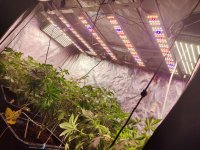Ca++
Well-known member
The link could be useful. It had my attention. I hear talk of plant specific light, and wonder what non-specific light is. I'm with Bugbee on this, where more is more. However if there is a special 10% recipe, that holds true for all our plants, I will have 10% more of it please. If that is possibleI agree. The point is it seems like you can gain 10% in par efficiency going one way, while the other way, optimizing plant response in the form of light utilization (g of harvest per umol of dli) can also gain 10-15% in yield. The study is pages behind ill see if i can dig it out, it also showed other benefits (significant higher terps, improvements in smell/flavour profiles, bringing back volatile smells) of going for a more horticentric approach.
Also, in the very end, of all the growers i know and see online (big time comercial is almost never around here): noone seems completely watt limited, more so space limited. If you want to bring your yearly results up (total crop values; yield, cycle time and quality)and have a hard time doing so with standard HE lights it may be better to go spec for 40w per square foot or even higher (you never have to use those extra watts if you dont want and need) and take a little extra yield + the other benefits.
Not asking telling anyone to stop believing efficiency is a good thing, it obviously is but there is more to it. What do you say to the home grower that grows his own smoke but want higher quality: do you think he prefers his 300w light for his 3x3 with great yields and decent quality or a 350w light with same to bigger yield, great smells and quality in the end after cure, plants looking happier and easier to grow all the way thru grow? Im betting there is a place in the market at least for this type of thinking. People really seems to like to stop growing mids and grow like a boss. No offense to your grow, it looks point. Also, I mean youre own mixed grow with hps and leds seems to indicate that you were wanting more and found a way? I hope to show that there is yet another way.
My gear is in development and hopefully growing after xmas. I hope to get at least one local grower on as a tester for this not to be one mouth shouting but to have some more support, enough at least for peeps to have a look at it. I also got my own "grow guru" onboard as a tester: hes got over 30 years of growing and breeding experience with the best setup and results ive seen or heard of. Keeps the original genetics of Delicatessen seed bank which he contributed with: his genetics are just 4 generations from mexico/himalaya etc. He generally keeps of the forums nowadays but his promised me at least something in terms of growlog for this.
Im really keen to see how that one pans out cause it would a very good side by side situation.
The way im going is for strips but i might do some boards later, should drop into standard qb heat sinks. Thats just dropping in a board into your system, not a whole as expensive grow setup. But all i good time
Our yield per watt is about the same, though I'm using 25% more watts, if LED alone. We (in the UK) can't get done for watts (yet) it's legally about plant count and size. Which is why I look at things like interlighting, to work the plants we have, harder. It's space constraints, rather than power constraints.
Just out in interest, I'm going to work it out. You have 400w a meter, using 0.4kwh, 12 times a day, 365 a year. 1750kwh with that kind of usage. Lets say you could save 10% of that, 175kwh cost's about £50 here. For perhaps 7 years, that 10% better 400w light, could save £350. The more usual ~600w light, might see saving of £500. These savings could pay to replace themselves. That's an important turning point in pricing. Where extra expenditure on a light, gives saving that make it's replacement free. It's like a 'bag for life'




